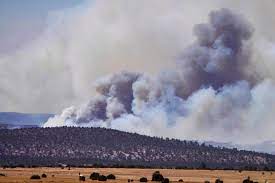The goal of this project is to characterize how and where novel wildfire-watershed governance systems are created and to understand whether different governance systems vary in terms of adaptive management, effectiveness, and fairness, as well as other identified outcomes during our research engagement.

Objectives:
- Build a broad inventory of current governance approaches to addressing wildfire risk on public, private, and Indigenous lands in the study areas. These governance systems will include any public, private, or Indigenous approaches and local approaches that use hierarchical, incentive-based, or co-management governance mechanisms to meet their goals.
- Characterize innovative governance systems and barriers, including developing watershed-specific case study analysis across New Mexico, and potentially Colorado, to better understand the governance approaches being used, the processes in which specific approaches were formed, and the results that are being achieved.
Charter Summary:
The increased frequency and severity of wildfires in the Intermountain West require new, collaborative approaches of governance. This research examines the dozens of new and emerging collaboratives to wildfire and watershed protection in order to understand their relative effectiveness, as well as where they occur and why. While historically the realm of the federal government, limited funding for forest management has given way to an increasing emphasis on collaborative governance arrangements and non-federal investments. This project seeks to characterize innovative governance systems in headwaters systems aimed at reducing the risk and potential severity of future wildfires and or responding to post-wildfire needs in terms of forest restoration. These governance approaches are often aimed at mitigating negative impacts to ecosystem services, especially water quality and quantity concerns, and thus human well-being outcomes. Our first component will be to (1) build a broad inventory of current governance approaches to addressing wildfire risk on public, private, and Indigenous lands across the IMW, and characterize these approaches and their outcomes. Our next component will be to (2) develop some case studies that highlight innovative governance arrangements across selected study areas. Finally, this charter is part of the CWG: Wildfire and Watersheds and will be helping identify important questions around governance for post-fire restoration in the upcoming year.
Team Members
- Courtney Flint (USU)
- Manuel Montoya (UNM)
- Alex Webster (UNM)
- Julie Padowski (WSU)
Students
- Olivia Kelly (UNM), PhD Student
- Marsella Macias (UNM), Master’s Student
- Alyssa Mineau (NMSU), PhD Student
- Julia Nelson (NMSU), Master’s Student
- Jaishri Srinivasan (UNM), Post-Doctoral Fellow
Publications:
- Jones, K. W., Padowski, J., Morgan, M., & Srinivasan, J. (2023). “Water utility engagement in wildfire mitigation in watersheds in the western United States.” Journal of Environmental Management (Vol. 347, p. 119157). Elsevier BV. https://doi.org/10.1016/j.jenvman.2023.119157
- Morgan, M., Webster, A., Piccarello, M., Jones, K., Chermak, J., McCarthy, L., & Srinivasan, J. (2023). “Adaptive governance strategies to address wildfire and watershed resilience in New Mexico’s upper Rio Grande watershed.” Frontiers in Climate (Vol. 5). Frontiers Media SA. https://doi.org/10.3389/fclim.2023.1062320
- Srinivasan, J., Jones, K., Morgan, M. “Unpacking the Taxonomy of Wildland Fire Collaboratives in the United States West: Impact of Response Diversity on Social-Ecological Resilience.” Environmental Management. 2025. https://doi.org/10.1007/s00267-025-02170-w